
IAG Highlights – 1st issue in 2024
The IAG is happy to release the 1st issue of its Highlights for 2024, focusing on the period January-March. Find this document in PDF here.
IAG – International Association of Geomorphologists
Geomorphology is the Interdisciplinary and Systematic Study of Landforms, their Landscapes and the Earth Surface Processes that create and change them

The IAG is happy to release the 1st issue of its Highlights for 2024, focusing on the period January-March. Find this document in PDF here.

The winner of the IAG Video Contest for the period January-March 2024 is Raúl Pérez López (Spain)! Find below his video and descriptive text.
If you want to participate in the contest, find the rules, guidelines and details on the procedure here.
A volcanic bomb field
by Raúl Pérez López, Spain
During the 2021 eruption in La Palma (Canary Islands), vigorous strombolian activity unleashed volcanic bombs around the cinder cone. The impact craters on the tephra deposits bear witness to the sheer force, yet amid this chaos, a mesmerizing pattern emerges. As the strombolian jets soared to heights of 300 meters, bombs of spatter and basalt were hurled into the air, creating a dense field surrounding the cone’s crater.
Regrettably, these ephemeral volcanic formations have since succumbed to natural erosion, with the once prominent bomb field now obscured beneath layers of subsequent tephra deposits. Scientists have intervened to remove larger projectiles, while those that remained were gradually buried under layers of ash and lapilli, their shapes reshaped by relentless winds and heavy rains. Fortunately, we are left with footage capturing the spectacle.

For this month only, we have two winners for the IAG Photo Contest in March 2024! They are Stefan Winkler (Germany) and Jana Eichel (The Netherlands)! Find below their photos and descriptive texts.
If you want to participate in the contest, find the rules, guidelines and details on the procedure here.
Tasman Glacier – a regional symbol for current glacier retreat
by Stefan Winkler, Germany
Tasman Glacier is the largest glacier in the Southern Alps of New Zealand, located immediately east of the Main Divide below the summit of Aoraki/Mt.Cook prominently towering in the centre of the image. The glacier is characterised by its lower tongue almost completely covered by supraglacial debris. This is typical for valley glaciers in the Southern Alps and the result of frequent denudational and gravitational processes triggered, for example, by seismic or major storm events. After several decades of mainly vertical downwasting during the middle of the 20th century, an initially supraglacial lake started to enlarge during the late 1990s causing the terminus of Tasman Glacier to retreat rapidly. This retreat by calving partly needs to be interpreted as ‘delayed’ response caused by the isolating effect of the supraglacial debris and not only the current climatic conditions. The huge and steep lateral moraines are exposed to strong paraglacial overprinting.
A glimpse into a glacial landscape of the future
by Jana Eichel, The Netherlands
Over the past two decades, Turtmann glacier (Valais, Switzerland), has been strongly retreating, revealing a glimpse into a glacial landscape of the future. A few years ago, large parts of the steep shaly bedrock in the picture were still covered by glacial ice. Now, glacial meltwater cascades down it on its way to the floodplain. On hot summer days, remaining glacier ice of the former icefall is breaking loose and can be heard crashing down the slope. Strong gullying processes dissect the steep lateral moraine during on-going paraglacial adjustment. At the gentler distal slope, however, plants are starting to colonize. Typical “greening” is substituted here by yellow coloring from prevalent Anthyllis spp. flowers. Small larch trees (Larix decidua) start to appear, further stabilizing this formerly eroding slope and turning it into a biodiverse alpine ecosystem.

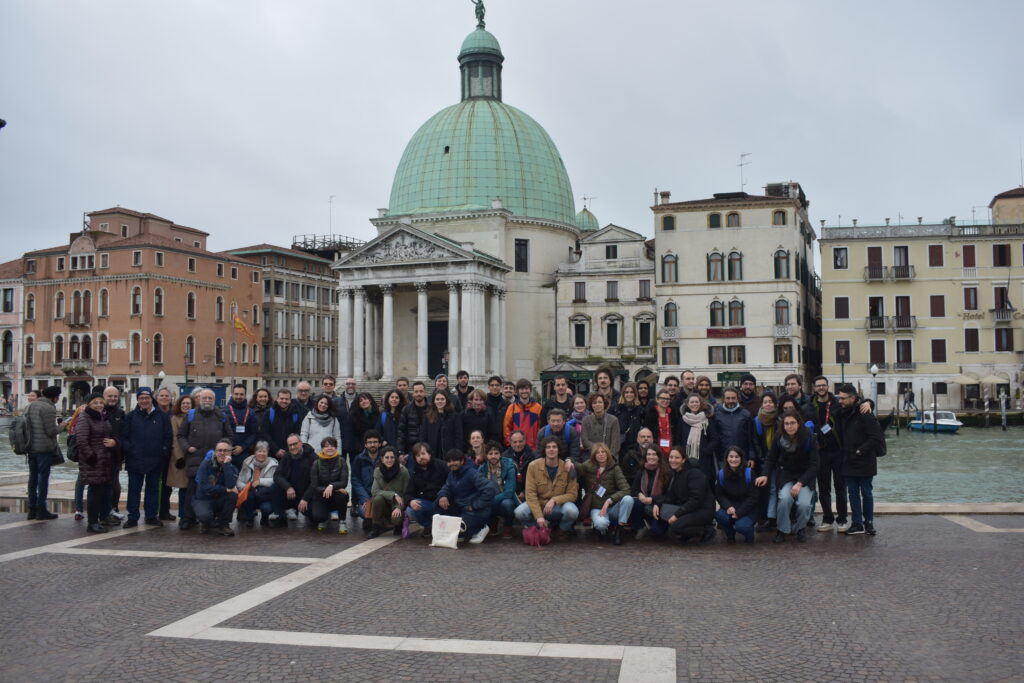
All participants in front of the railway station in Venice. Credits: Denovan Chauveau (University of Venice Ca’ Foscari).
The Italian Young Geomorphologists (IYG) Group of the Italian Association of Physical Geography and Geomorphology (AIGeo) organised the Xth AIGeo Young Geomorphologists’ Day and the IIIrd IAG International Young Geomorphologists’ Meeting in Venice (Italy), on 1-2 March 2024. The IAG offered 3 Grants to support the participation of three Young Geomorphologists (inside and outside Europe). Congratulations to all Grant Holders!
The theme of that combined event was “Climate Change and the Role of Early-Career Geomorphologists”. Therefore, Grant Holders had the opportunity to learn more about the “complex interplay of natural processes and climate change”, but also to present their research related to that field. Overall, meeting other early-career researchers provided grant holders with “valuable advice on research and managing a PhD“. They also highlight a friendly atmosphere between participants, during the informal event and the field trip. Said field trip took place in Venice, and was dedicated to the theme “Living on the water towards 2100“. Hence, Grant Holders had the opportunity to learn about the returning period of floods, diversion of rivers, ground subsidence… with an emphasis on “changes in sea level and their relationships with the urban geomorphology of the city of Venice”.
Overall, all three Grant Holders thank the IAG for the financial support that allowed them to participate in this “incredibly enriching and beneficial event“.
Find their full reports here:

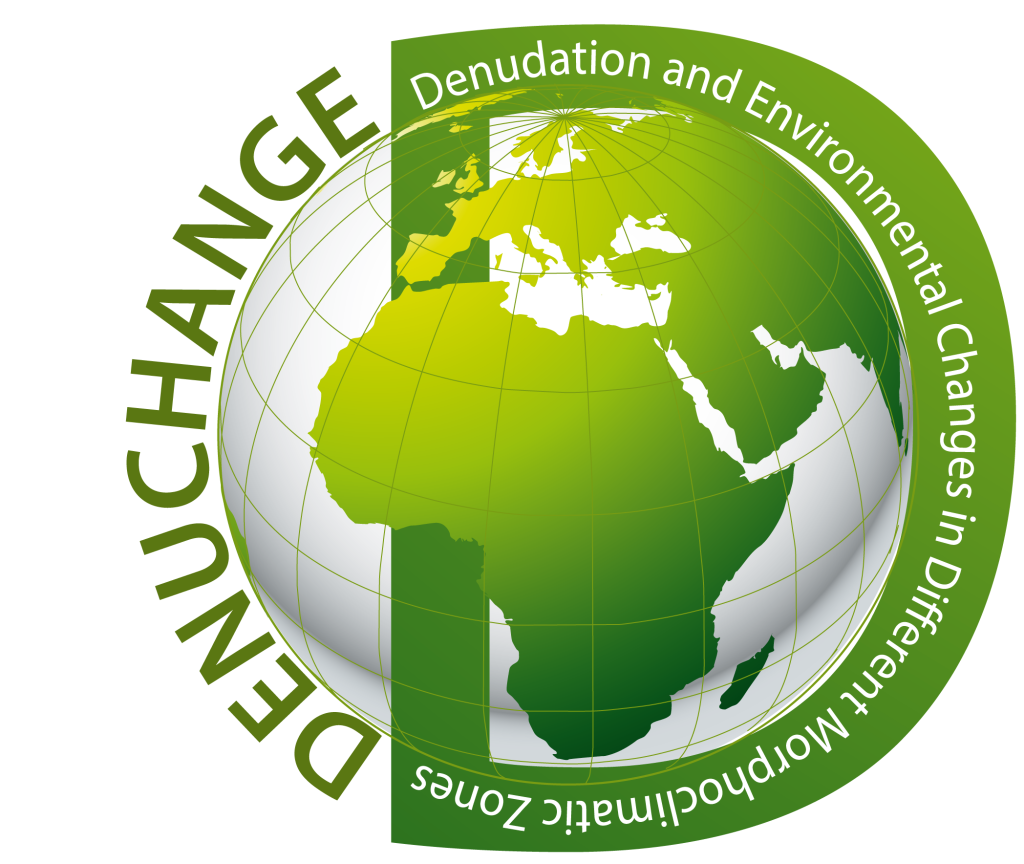 The International Association of Geomorphologists (IAG) announces the offering of 2 travel grants of 450 € (four hundred and fifty Euros) to support the participation of two Young Geomorphologists* worldwide (except those based in Italy) in the IAG-DENUCHANGE-2024 Working Group Workshop (Rome, Italy, 23–26 September 2024).
The International Association of Geomorphologists (IAG) announces the offering of 2 travel grants of 450 € (four hundred and fifty Euros) to support the participation of two Young Geomorphologists* worldwide (except those based in Italy) in the IAG-DENUCHANGE-2024 Working Group Workshop (Rome, Italy, 23–26 September 2024).
The meeting will take place at the Earth Science Department of Sapienza University of Rome, followed by two days of field trips. The first day field trip is organized in the Upper Orcia Valley (southern Tuscany), which is characterized by sub-humid badland processes and landforms, while the second day field trip focuses on analysing erosional processes on a broader time scale (since the Pleistocene) and spatial scale (basin scale) at the High Tiber Valley basin. The Workshop aims to gather various Earth scientists from all around the world to contribute to a better understanding of the Earth surface systems, and to facilitate future collaboration. The program of the Workshop includes a special session dedicated to presentations (both oral and poster) by Young Geomorphologists. During the Workshop, the Young Geomorphologists will have the opportunity to meet and engage discussions with scientists from various countries, and visit cutting-edge scientific study sites.
For further information on the Workshop and early registration, please visit:
https://www.aigeo.it/homepage/denuchange-2024/
Applications from candidates who already achieved one or more IAG grants totalling 500 euros or more in the past 3 years will not be eligible.
Candidates for IAG GRANTS are requested to submit the following files by Monday 15th April 2024:
Files should be submitted to:
Anita Bernatek-Jakiel and Efthimios Karymbalis, IAG Training Officers
e-mail: iaggrants@gmail.com (e-mail subject: “IAG-DENUCHANGE-2024”)
The selection of candidates will be carried out by a Commission appointed by the IAG Executive Committee. For further information on the IAG Grants, feel free to contact the IAG Training Officers.
Prof. Efthimios Karymbalis & Dr. Anita Bernatek-Jakiel
IAG Training Officers
karymba@hua.gr / anita.bernatek@uj.edu.pl
*Undergraduate or postgraduate – Masters/PhD students or scientists who have received their highest degree, i.e. BSc, MSc, or PhD, within the past seven years. Provided parental leave fell into that period, up to one year of parental leave time may be added per child, where appropriate.

The International Association of Geomorphologists (IAG) announces the offering of 2 travel grants of 300 euros (three hundred euros) to support the participation of two Young Geomorphologist (except those based in Poland) in the 1st Workshop of the IAG Urban Geomorphology Working Group (Kraków, Poland, 3–6 September 2024). Additionally, the Workshop organizers offer a reduced registration fee of 160 euros for the IAG grant holders.
The event titled “Geomorphology, geodiversity and geosites in urban areas” is organized by the IAG Urban Geomorphology Working Group. It aims to bring together urban geomorphologists and geographers from all continents to contribute to a better understanding of ancient and modern geomorphological processes taking place in the world’s urban areas, as well as to facilitate future cooperation. The program consists of lectures that will be given by invited guests as well as presentations and posters of participants. One day will be devoted to the workshop for young geomorphologists about GIS application in urban geomorphology. Besides the scientific sessions, a field trip to Upper Silesia Region will be organized.
Link for early registration: https://forms.gle/bpeVhLs5Q81gkGgc7
Applications from candidates who have already achieved one or more IAG grants totalling 500 euros or more in the past 3 years will not be eligible.
Candidates for IAG GRANTS are requested to submit the following files by Monday 15 April 2024:
Files should be submitted to:
Anita Bernatek-Jakiel and Efthimios Karymbalis, IAG Training Officers
e-mail: iaggrants@gmail.com (e-mail subject: “Urban Geomorphology 2024”)
The selection of candidates will be carried out by a Commission appointed by the IAG Executive Committee. For further information on the IAG Grants feel free to contact the IAG Training Officers.
Prof. Efthimios Karymbalis & Dr. Anita Bernatek-Jakiel
IAG Training Officers
karymba@hua.gr / anita.bernatek@uj.edu.pl
*Undergraduate or postgraduate – Masters/PhD students or scientists who have received their highest degree, i.e. BSc, MSc, or PhD, within the past seven years. Provided parental leave fell into that period, up to one year of parental leave time may be added per child, where appropriate.

The Young Geomorphologists Forum (YGF) of the Indian Institute of Geomorphologists (IGI) organised its 4th Intensive Training Program for Young Geomorphologists. It took place at the Centre for the Study of Regional Development of the Jawaharlal Nehru University, on 28 November to 1 December 2023. Participants also participated in a field trip in Kalesar, Yamunanagar, Haryana.
The Intensive Training Program was focused on the theme “Methods of Geomorphological Mapping and Geochronology“, and aimed at training Young Geomorphologists to geomorphological mapping supported by OSL and geochronology dating techniques. The event was divided into four parts: an inaugural session, lecture session & training in the OSL and Geochemistry laboratory, intensive field exercises, and a session on post-processing of collected field data.
Among the 60 applications were selected 25 participants from 16 different institutions. Feedback from the participants is overall extremely positive – find the full report here.

The winner of the IAG Photo Contest in February 2024 is Stéphane Jaillet (France)! Find below his photo and descriptive text.
If you want to participate in the contest, find the rules, guidelines and details on the procedure here.
Rock comets from the Patagonian karsts
by Stéphane Jaillet, France
On the western side of Chilean Patagonia (50°S), the lapiazed surfaces of the karsts of Madre de Dios Island are subject to intense dissolution. The abundance of precipitation (8,000 mm / year) favours the highest dissolution rate in the world. Since the glaciers retreated, erratic blocks have remained on the ground. They protect the underlying limestone from dissolution and wind. Behind the boulders, a ridge has been preserved. We have named these amazing forms the rock comets of limestone Patagonia.

The IAG Working Group on Urban Geomorphology organises its 1st Workshop! The overarching goal of that workshop is to bring together urban geomorphologists worldwide, which will lead to a better understanding of overall matters in ancient and modern urban geomorphology, and will help to build future collaborations.
The workshop will be held in Kraków (Poland), on 3-6 September 2024, with the general theme “Geomorphology, geodiversity and geosites in urban areas“. The programme includes plenary lectures, oral & poster sessions, training on a GIS software (dedicated to early-career researchers), as well as two field trips.
The deadline to submit abstracts is 31st May. Find the first circular of the event here, and the link for early-bird registration here.
The IAG will support the participation of two young Geomorphologists via two grants – more information soon!

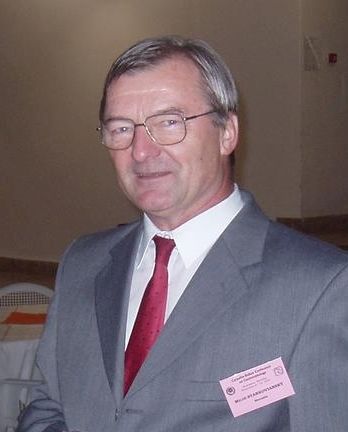 On January 24, 2024, at the age of 76, the eminent Slovak geomorphologist Miloš Stankoviansky passed away.
On January 24, 2024, at the age of 76, the eminent Slovak geomorphologist Miloš Stankoviansky passed away.
He was born on July 14, 1947, in Myjava. His interest about environment and history of his birth place drove him to the study of geography at the Faculty of Natural Sciences, Comenius University in Bratislava (1965 to 1970).
In years 1970 to 2001 he worked at the Institute of Geography of the Slovak Academy of Sciences in Bratislava (IG SAS), where he finished his PhD study by defending a thesis entitled “Geomorphological conditions of the Hrabutnica River basin and the adjacent area with special regard to recent relief-forming processes” in 1977. Then he continued to work at the IG SAS as a researcher, and long-time scientific secretary. His research activities were mainly focused on dynamic geomorphology. He was significantly influenced by his collaboration with prof. Asher P. Schick of the Hebrew University of Jerusalem. In the 1990s, he led a sub-team of IG SAS in a trilateral project coordinated by this internationally renowned fluvial geomorphologist. The evaluation of the response of various watersheds to the human activity was the aim of the project. The project directed his research activities towards the impact of human activities on recent slope processes and gully erosion. Gullies then became his companions until the end of his scientific research career. In 2001, he moved from the Institute of Geography of the Slovak Academy of Sciences to the Department of Physical Geography and Geoecology of the Faculty of Natural Sciences of Comenius University in Bratislava, where he had been lecturing externally since the late 1980s. Here he completed the work on his profile monograph “Geomorphological response of environmental changes in the territory of the Myjavská pahorkatina Upland“, for which he was awarded the Literary Fund Prize in 2003 and which he defended as his habilitation thesis in the same year. In 2003 he became the head of this Department and served in this position until 2011. In 2015 he was awarded the Gold Medal of the Faculty.
In the course of his professional career, Miloš Stankoviansky was involved in various aspects of geomorphological research – from general geomorphology and basic geomorphological mapping, through (morpho)structural, dynamic and historical geomorphology, to anthropogenic, engineering and environmental geomorphology. However, he gained the most significant recognition in the field of the geomorphological response of environmental (climatic and anthropogenic) changes in the present and historical landscape, due to the influence of runoff and ploughing processes. He was a pioneer of such research in Slovakia and built his scientific school based on that topic. The results of his research in the Myjavská pahorkatina Upland, through presentations at conferences, publications in renowned journals, conducting of excursions and accompanying numerous guests, have made it so visible that foreign colleagues have ranked it among the most important European research sites in this field.
He has achieved these results thanks to intensive contacts with the international scientific community. He has participated in exchange study and lecture stays in Florence (1993), Tokyo, Kyoto and Tsukuba (1996), Thessaloniki (2004), Belfast (2005), Kraków (2006 and 2009), Ljubljana (2007), Pilsen (2010) and has actively participated in dozens of international conferences. At several congresses of the International Association of Geomorphologists (IAG/AIG) he was the official representative of the Association of Slovak Geomorphologists, which he co-founded in 1996 and became the first chairman of its executive committee. He was also one of the protagonists of the activation of the Carpatho-Balkan Geomorphological Commission (KBGK) and from 2003 to 2007 he was the President of this regional geomorphological group. As President of the KBGK, he took the initiative to raise the visibility of this organization by obtaining the endorsement of the International Association of Geomorphologists, which was achieved by the adoption of the Carpatho-Balkan-Dinaric Regional Working Group (IAG/AIG CBDR-WG) at the IAG/AIG Congress in Zaragoza (2005). He has been its Chair throughout the whole period of its functioning from 2005 to 2013. He initiated and co-edited the monograph Recent Landform Evolution: the Carpathian-Balkan-Dinaric Region (Springer, 2012), which was co-edited by geomorphologists from all eleven member countries. He also served as the national representative of the Steering Committee of the projects on soil erosion within the European COST Programme: Action 623 Soil Erosion and Global Change (2001 to 2003), Action 634 On- and Off-site Environmental Impact of Runoff and Erosion (2004 to 2008).
The high international scientific reputation of Miloš Stankoviansky is illustrated by the organization of several very successful international conferences (International Symposium Time, Frequency and Dating in Geomorphology, 1992, COMTAG, IGU; International Symposium Geomorphic Response to Land Use Changes, 2000, GERTEC, IGU; Carpatho-Balkan Conference on Geomorphology, 2003), scientific field trips, invited lectures at the Universities of Leuven (1998), Kraków (2004), Louvain-la-Neuve (2006) and Brno (2011), and co-editorship of several special issues of international peer-reviewed journals. He was also a long-standing member of the editorial boards of several journals (Geomorphologia Slovaca et Bohemica, Studia Geomorphologica Carpatho-Balcanica, Folia Geographica and Landform Analysis).
Miloš Stankoviansky was a scientific and pedagogical personality of both Slovak and international geography and geomorphology, an extremely motivated and enthusiastic scientist, a tenacious field researcher, an excellent collaborator, a meticulous administrator and organizer, a friendly, helpful and competent teacher and, above all, a very honest, hard-working and beloved fellow, husband, father and grandfather.
Zora Machová, Jozef Minár, Ján Novotný


The 37th International Geological Congress will take place in Busan (Republic of Korea) on 25 to 31 August 2024! The IAG is co-sponsoring the session T10-S2: “Landslides and climate change”.
Submit your abstract before 16 February here: https://www.igc2024korea.org/content/14410.
Deadline for regular registration is 26 July, and 26 April for early-bird registration: https://www.igc2024korea.org/content/14409.

The winner of the IAG Photo Contest in January 2024 is Roos van Wees (Belgium)! Find below her photo and descriptive text.
If you want to participate in the contest, find the rules, guidelines and details on the procedure here.
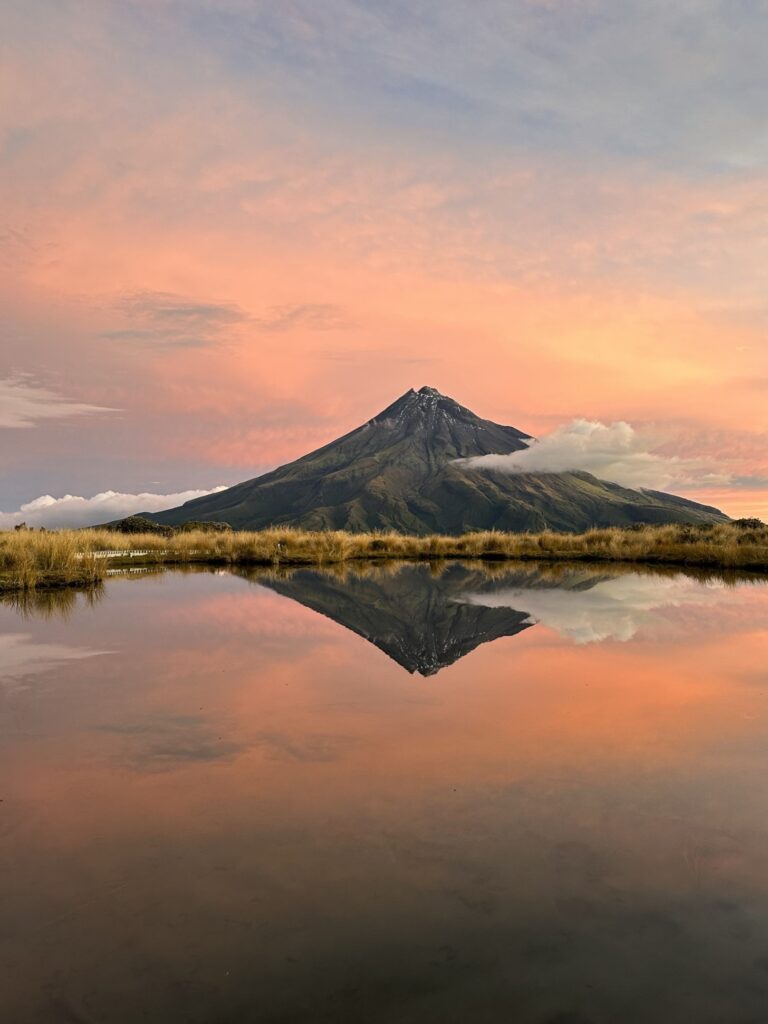
The reflection of Taranaki
by Roos van Wees, Belgium
The Taranaki volcano, also known as Mount Taranaki or Egmont lies on the northern island of New Zealand. It is an active stratovolcano with a perfectly symmetrical cone. The area around the volcano is protected in a National Park attracting many hiking tourists. It forms a volcano chain with the neighbouring and older Pouakai and Kaitake volcanoes, which is visible from satellite images. This chain is a unique example of how the age of a volcano is reflected in the maturity of the geomorphology of the volcanic landscapes, with Taranaki as the young and pristine example. Its unique topography and diverse ecosystems provide insights into geological history and ecological adaptations. Taranaki is sacred to the Mãori in New Zealand featuring prominently in their myths and legends, serving as a symbol of both natural wonder and cultural identity, fostering a deep connection between science and heritage.

The IAG is happy to release the 4th issue of its Highlights for 2023, focusing on the period October-December. Find this document in PDF here.
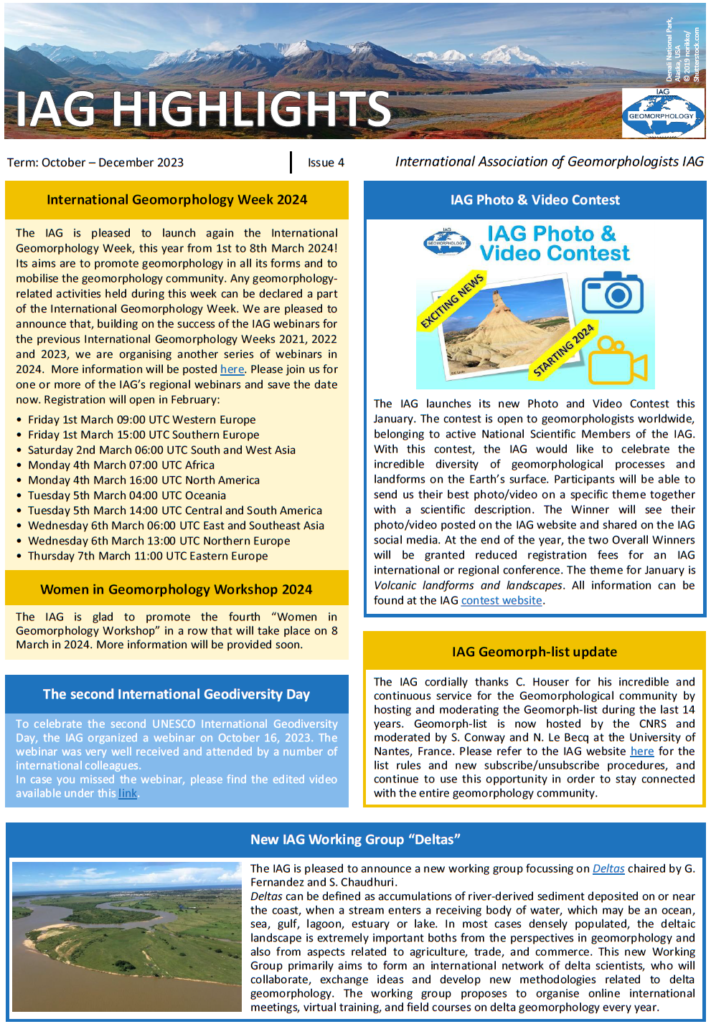


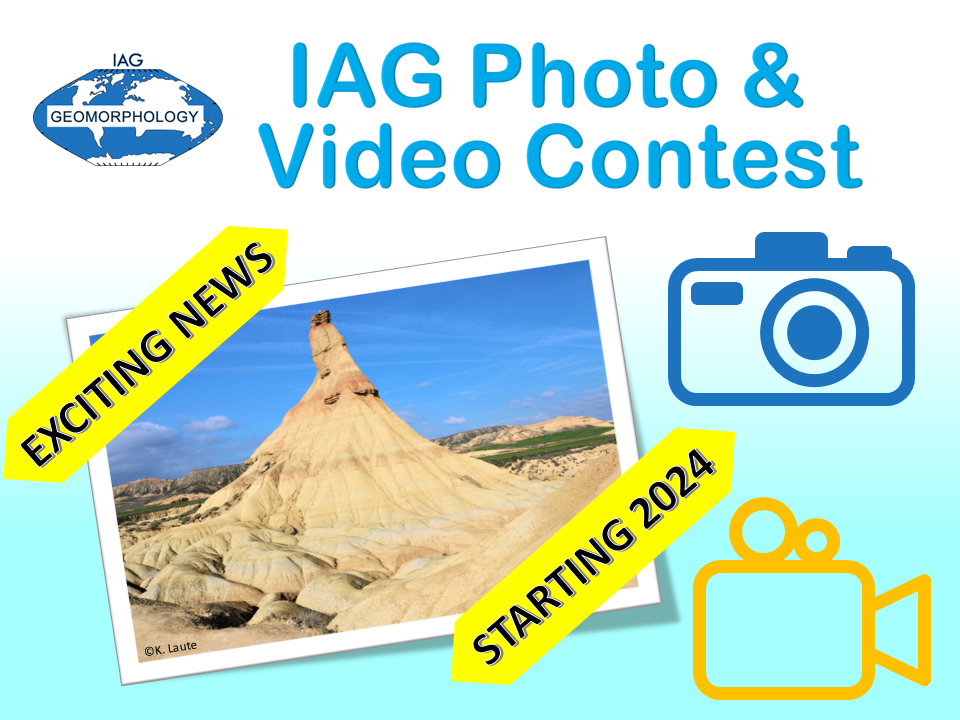 The IAG launches a Photo & Video contest! Each month (for photos) and every three months (for videos), the geomorphology community will be able to submit their best photo/video related to a given theme. A Selection Committee will designate a winner at each iteration, and two Overall Winners per year – who will be granted reduced registration fees to attend one IAG conference!
The IAG launches a Photo & Video contest! Each month (for photos) and every three months (for videos), the geomorphology community will be able to submit their best photo/video related to a given theme. A Selection Committee will designate a winner at each iteration, and two Overall Winners per year – who will be granted reduced registration fees to attend one IAG conference!
Visit the Contest page to get all details: http://www.geomorph.org/iag-photo-video-contest/

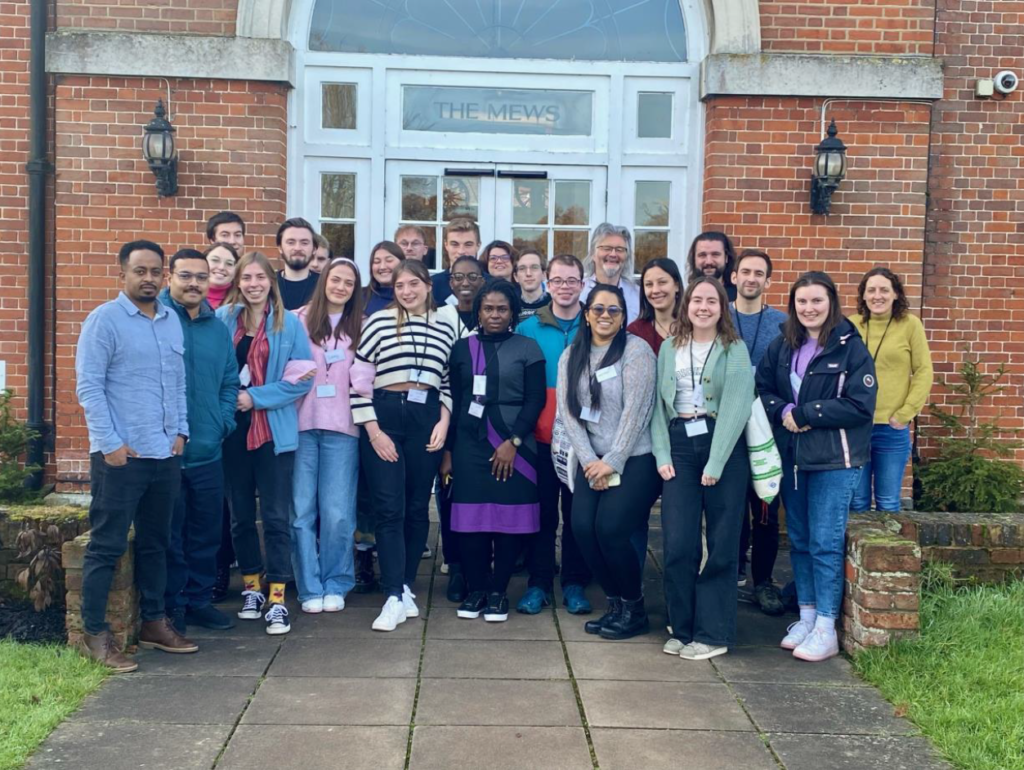
The workshop attendees and tutors (photo from the report of Letizia Pace)
Maria Kotowska and Letizia Pace were awarded grants of 300€ each to attend the Post-Graduate Training Workshop organised by the British Society for Geomorphology (BSG) – and more specifically by Dr. Lucy Clark and Prof. John Wainwright. This grant allowed them to stay four days at the Cumberland Lodge (Windsor, UK) – find their full reports in pdf here:
Both reports highlight an “unforgettable” and “incredibly formative” experience. The workshop covered a wide range of topics: nature and ethics of the PhD, management of a scientific network, writing and publishing a paper, time management and project planning… Additionally, participants were introduced to the use of Python programming, and were given the opportunity to present their research projects – which represented a good practise for public speaking. Overall, the workshop ran in a “supportive and relaxed atmosphere”, which helped participants in making connections with each other. They also very much appreciated the comfort of the Cumberland Lodge, and the beauty of its surroundings.

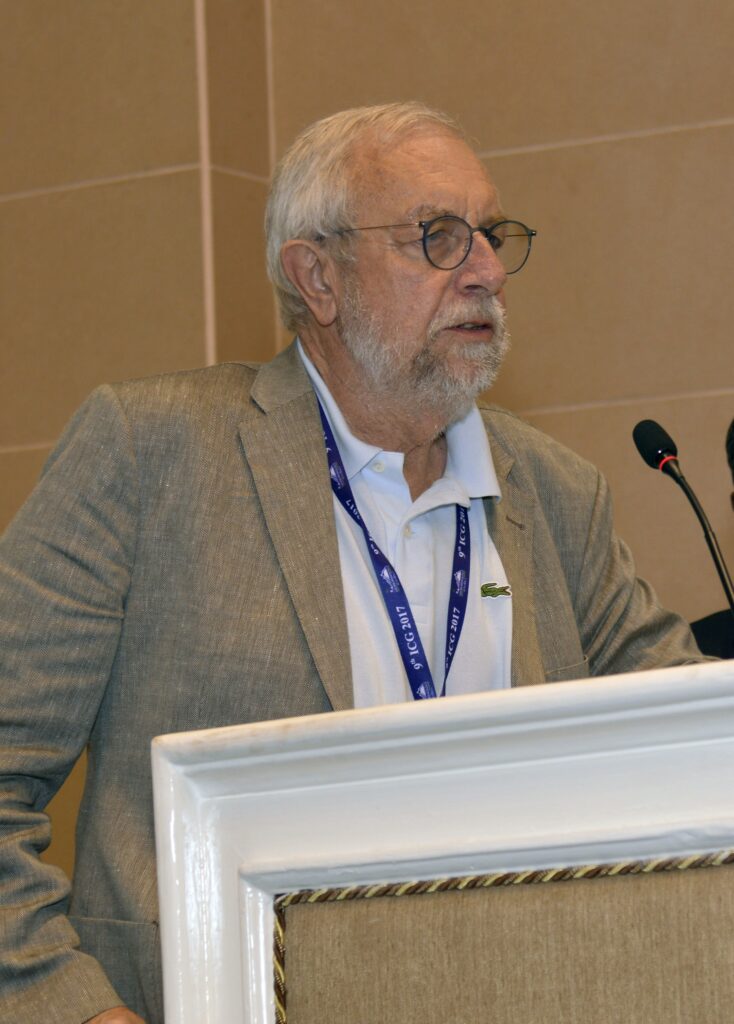 Dear colleagues,
Dear colleagues,
We learnt with great sadness that our colleague and friend Morgan De Dapper passed away. He was a full honorary member of the Classe des Sciences Naturelles et Médicales (Class of Natural and Medical Sciences) from the Belgium Académie Royale des Sciences d’Outre-Mer (Royal Academy of Overseas Sciences), geographer, geomorphologist, former Secretary General of the International Association of Geomorphologists and founder of the IAG Working Group ‘Geoarchaeology’.
Born in Deinze (Belgium) on the 17th of July 1947, he passed away there on the 17th of November 2023.
He began his scientific journey in Greece when he was still a student, with the Pharos scientific expedition; but his PhD study field was in the Katanga province, in the Democratic Republic of the Congo (former Zaïre, Africa). He spent his entire career in the Rijksuniversiteit Gent (Gand University) to which, as a Flamand and lecturer, he was deeply attached. He started working on his thesis there as an intern, in the Laboratorium voor Fysische Aardrijkskunde en Regionale Bodemkunde (Laboratory of Physical Geography and Regional Pedology). He then became Assistant, First Assistant and Project Officer in the same laboratory. Morgan De Dapper obtained his PhD in Geography in 1978, and became a lecturer on the 1st of October 1991 in the Laboratoire de Géographie Physique (Laboratory of Physical Geography, which name changed for ‘Geography Department’ in 1993). He was appointed Professor in 2002, Full Professor in 2008, and Professor Emeritus in 2012.
Morgan De Dapper was elected Associated Member of the Belgium Section des Sciences Naturelles et Médicales from the Académie Royale des Sciences d’Outre-Mer on the 4th of September 1989, promoted Full Member on the 30th of April 1993, and finally reached the status of Honorary Member in 2012. He was the head of his Section from 2005 to 2013, and the head of the whole Académie in 2005.
His research mainly focused on regional geomorphology and geoarchaeology in tropical and Mediterranean regions – with particular attention drawn to less-favoured countries. He worked in Portugal, Spain, Italy, Greece, Türkiye (Anatolia), Syria, the Palestinian territories, Jordan, Bahrein, Iran, Egypt (Nil delta and Upper Egypt), Soudan (Nubia), Yemen (Socotra Island), Morocco, Tunisia, Cameroon, Democratic Republic of the Congo, Zimbabwe, Madagascar, Malaysia, Vietnam, Brazil, and Chile (Easter Island). He founded the IAG Working Group ‘Geoarchaeology’ in 1995, of which he has been President and Vice-President. He was also President of the Association Belge des Géomorphologues (Belgian Association of Geomorphologists), Vice-President of the Société Belge de Géographie (Belgian Society for Geography Studies), member of the editorial board of BELGEO (the Belgian geography journal), member of the National Committee for Quaternary Studies from the Académie Royale des Sciences de Belgique. Morgan De Dapper was also member and former President (2005) of the Académie Royale des Sciences de Belgique, where he was also President of the Commission sur le Développement et l’Environnement (Commission for Development and Environment).
He had strong convictions, was highly committed to the collective, and was a man of great scientific and human generosity. He was a driving force for the IAG, which he helped to found in 1989. For his commitment in the IAG, rare in terms of continuity and strength, and also for his international reputation and scientific influence, I had the great pleasure to award him the title of IAG Honorary Fellowship in Delhi in 2017 – the highest distinction of the Association.
With unwavering support for less-developed countries, he did his best to help the emergence and visibility of young African and Eastern European researchers. When I was the President of the Groupe Français de Géomorphologie (French Geomorphology Group), I remember of his support for Belgium to join Italy and France in developing a scientific network with young Romanian researchers.
Beyond our scientific collaborations, we developed strong ties of friendship. His overflowing activity would not have been possible without the support of his loving family. We lost a friend and colleague. Our thoughts are with his beloved wife and family.
Eric Fouache
Professor – UFR de Géographie et Aménagement
Sorbonne Université
UR Médiations Sciences des Lieux, Sciences des Liens
Senior Honorary Member of the IUF
Former IAG President (2013-2017)

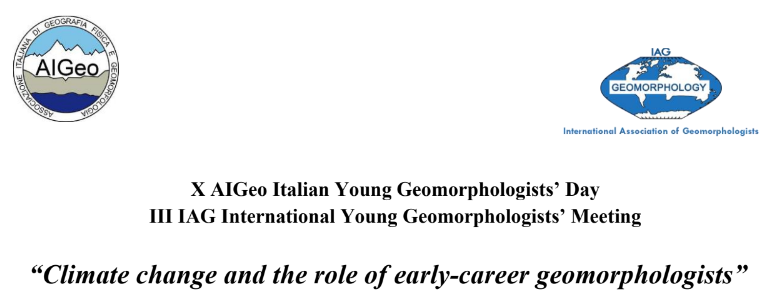
The IAG announces the offering of 3 travel grants: one grant of 300 euros (three hundred Euros) to support the participation of one Young Geomorphologist from European Countries and two grants of 450 euros (four hundred and fifty Euros) to support the participation of two Young Geomorphologists from countries outside Europe (in both cases preference will be given to countries without Young Geomorphologists’ National Group) in the Xth AIGeo Young Geomorphologists’ Day and III IAG International Young Geomorphologists’ Meeting (Venice, Italy, 1–2 March 2024)].
The title of the event is: “Climate Change and the Role of Early-Career Geomorphologists” organized by the Italian Young Geomorphologists (IYG) Group of the Italian Association of Physical Geography and Geomorphology (AIGeo). Its aim is to favour the scientific progress of the young researchers by stimulating the exchange among those operating in the different branches of Geomorphology. The program consists of the presentation and discussion of the scientific results obtained by young researchers while one session of the event will be the “IAG Southern Europe Webinar” during the International Geomorphology Week 2024. Besides the scientific sessions, the field trip “Living on the water towards 2100” will be organized. More info on the event may be found on the AIGeo webpage: https://www.aigeo.it/x-young-geomorphologists-day-and-iii-iag-international-young-geomorphologists-meeting-venice-1-2-march-2024/
Applications from candidates who already achieved one or more IAG grants totalling 500 euros or more in the past 3 years will not be eligible.
Candidates for IAG GRANTS are requested to submit the following files by Friday 22 December 2023:
Files should be submitted to:
Anita Bernatek-Jakiel and Efthimios Karymbalis, IAG Training Officers
e-mail: iaggrants@gmail.com (e-mail subject: “Venice 2024”)
The selection of candidates will be carried out by a Commission appointed by the IAG Executive Committee. For further information on the IAG Grants feel free to contact the IAG Training Officers.
Prof. Efthymios Karymbalis & Dr. Anita Bernatek-Jakiel
IAG Training Officers
karymba@hua.gr / anita.bernatek@uj.edu.pl


The IAG is happy to give its auspices for the Summer School in Geomorphological Mapping, which will be held in Camerino (Italy) on 2nd to 8th September 2024! This event is organised by the Geology Division of the University of Camerino, and supported by the AIGeo (Italian Association of Physical Geography and Geomorphology), the ISPRA (Higher Institute for Environmental Protection and Research of the Ministry of Ecological Transition of the Italian Government) and the CNG (National Council of Geologists).
The aim of the course is to develop the experience of participants in geomorphological mapping of tectonically active areas. The Summer School will include a few days of teaching, followed by the application of the course by creating specific geomorphological maps. Preparation of those maps will include, among others: analysis of remote sensing data, field survey, sample collection and subsequent laboratory analyses…
The University of Camerino is located in Central Italy, which underwent a strong seismic crisis in 2016-2017. Hence, the Summer School will be focused on the remaining geomorphological features of that crisis: surface faulting, large landslides, or deep-seated gravitational slope deformations.
Find the circular of the Summer School here, with email addresses of the organisers.


IAG Grant Holders in the Conference venue
The Southern African Association of Geomorphologists organised its Biennial Conference on 28-30 September 2023 in Hogsback (Eastern Cape of South Africa). The IAG offered 8 Grants to help Young Geomorphologists from the Emerging Career Researchers (ECRs) and Southern African Young Geomorphologists (SAYG) to attend this event. Congratulations to all Grant Holders!
All Grant Holders report a wonderful experience, and overall a great opportunity to present their work, to meet with experts in their research topics, but also to interact with other researchers who were at an early stage of their career. Through the Intensive Course, Grant Holders were able to participate in a pre-excursion field trip focused on wetlands (more specifically peatlands), including field sampling and subsequent analysis in the laboratory. Grant Holders were also involved in the organisation of the conference, from abstract selection to session chairing. Find the report from the organisers of the SAAG Young Geomorphologists Training Program here.
Find the list of all Grant Holders with their full reports here:

 The IAG Regional Conference on Geomorphology was held in Cappadocia (Türkiye), on 12-14 September 2023. The IAG was happy to offer travel grants, helping 10 Young Geomorphologists to attend this event. Congratulations to them!
The IAG Regional Conference on Geomorphology was held in Cappadocia (Türkiye), on 12-14 September 2023. The IAG was happy to offer travel grants, helping 10 Young Geomorphologists to attend this event. Congratulations to them!
Overall, they all enjoyed participating in the IAG Regional Conference on Geomorphology 2023 “Geoheritage and Geodiversity”, as well as in the subsequent Intensive Course “High Resolution Mapping and Cosmogenic Dating of Fluvial Landforms”. Their reports particularly highlight the quality of the talks, whether during the scientific sessions or the Intensive Course. They also describe the associated field trip as an unforgettable experience.
Find the list of all Grant Holders with their full reports here:

IN MEMORIAM. Prof. Mateo Gutiérrez-Elorza

Prof. Mateo Gutiérrez-Elorza died last September 9, in Zaragoza, Spain. A sad and curious coincidence, just the day after the closure of the 16th National Meeting on Geomorphology, held in that same city. During the opening ceremony of the meeting, the President of the Sociedad Española de Geomorfología, Dr. Gloria Desir, mentioned Mateo’s crucial and leading role in the development of Geomorphology in Spain, and his significant international contributions, and so did the speakers of the opening and closing lectures. Mateo’s scientific category and friendly character made him a generally respected and loved colleague, both in Spain and internationally. Not surprisingly, because of the above-mentioned coincidence, his family, colleagues and friends have already received numerous expressions of condolence, from different corners of Spain and the world.
Born in Burgos, N Spain, in 1941, Mateo got his BSc (1963) and PhD (1969) in Geology at the Universidad Complutense, Madrid. Between 1970 and 1977, he lectured at the Universidad Complutense and the Colegio Universitario de Teruel. He became Lecturer at the Universidad de Zaragoza in 1977 and Full Professor in 1980.
He was an enthusiastic researcher, interested in a wide spectrum of geomorphological topics, and made significant contributions in several of them, often of an innovative character. To mention a few: Periglacial environments (Gutiérrez and Peña, 1976, 1981; Gutiérrez and Gutiérrez, 2014b). Geoarchaeology, with contributions (Burillo et al., 1981, 1984, 1985) that were pioneer in Spain. Karst, especially his work on poljes (Gutiérrez et al., 1983; Gracia et al., 1996, 2001, 2002) and doline fields in gypsum and limestone terrains (Gutiérrez and Peña, 1979 a, 1979 b; Gutiérrez et al., 1985, 2007; Benito and Gutiérrez, 1988; Gutiérrez and Gutiérrez, 1998; Galve et al., 2009). Netectonics (Capote et al., 1981; Gutiérrez et al., 2008). Analysis of the geomorphic effects of extreme hydrological events (Gutiérrez et al., 1998b, 2003). Geomorphological cycles related to climate oscillations (Gutiérrez and Peña, 1998; Harvey and Gutiérrez-Elorza, 2005). Talus flatirons (Gutiérrez Elorza and Sesé Martínez, 2001; Gutiérrez et al., 1998a, 2006, 2010), yardangs (Gutiérrez et al., 2005; Gutiérrez and Gutiérrez, 2014a). Quantification of erosion in badlands and other arid environments in the Ebro valley, using different field techniques (Gutiérrez et al., 1988, 1997; Sancho et al., 1991; Desir et al., 1995; Sirvent et al., 1997). He presented an excellent synthesis on this topic during his entry lecture at the Academia de Ciencias Exactas, Físicas, Químicas y Naturales de Zaragoza (Gutiérrez-Elorza, 1998).
He also made important contributions of a more general, theoretical character. Worthy of mention are those on the history of Geomorphology in Spain (Gutiérrez-Elorza, 1990) and the world (Gutiérrez-Elorza and Pérez-González, 1992), as well as his books (Spanish and English versions) Climatic Geomorphology (2001 and 2005) and Geomorphology (2008 and 2012). Also, the two volumes edited on Landscapes and landforms of Spain (Gutiérrez and Gutiérrez, Eds., 2014) and Landforms of the world. An illustrated guide (Gutiérrez and Gutiérrez, 2016). The latter work contains an excellent compendium of photographs, a thematic catalogue of landforms. They all are examples of Mateo’s wide knowledge and interest on all aspects of Geomorphology. Reflection of this interest are his numerous PhD students, working in different research institutions of Spain, a number of which are internationally recognised scientists.
He was an active participant in several international events (organised by the International Geographical Union and the International Association of Geomorphologists) leading to the important transformation experienced by Geomorphology, both internationally and in Spain during the nineteen eighties. His impulse was behind the considerable expansion of geomorphological research in Spain in the later part of last century. Following the International Conferences on Geomorphology of Manchester (1985) and Frankfurt (1989), he was the leading force for the organisation of the I Reunión Nacional de Geomorfología (Teruel, Spain, 1990), during which he was elected first President of the Sociedad Española de Geomorfología (SEG). Over 30 years later, the SEG is active and strong, showing the success of Mateo’s original idea of harmoniously integrating geographers and geologists into the common task of fostering this field of the Earth Sciences.
Special mention must be made to the organization of the 6th International Conference on Geomorphology, held in Zaragoza in 2005. It was a very successful event, with 861 participants from 61 countries. Twenty field trips were organised, all of them with very complete field guides, and a congress for young geomorphologists, including an excursion, took place as well. The great effort this complex event required, and its success, was possible thanks to the work of a handful of people, mostly young geomorphologists, inspired and enthusiastically led by Mateo.
Many of us remember him at his office, surrounded by books and offprints trying to understand the processes and factors that determine the evolution of landforms. He was a passionate scientist, a tireless reader full of questions for which he sought answers. We will always remember his relentless interest to communicate his passion and knowledge about landforms.
Last, but surely not least, he was a lovable person. He had a friendly, amusing character, especially when he was in the field. He enjoyed being with friends, be it in the field or at the office, discussing different (scientific and other) topics, and generously sharing data, knowledge and questions. In the last few years, deterioration of his health forced him to retire from the front geomorphological line, but he has left behind a notable scientific heritage and a large number of friends who will miss his presence, closeness and good humour. We owe him very much and will always remember him as a great scientist, decisive for the development of Geomorphology in Spain.
October 2023
Antonio Cendrero, Universidad de Cantabria, Santander
José María García-Ruiz, Instituto Pirenaico de Ecología, CSIC, Zaragoza

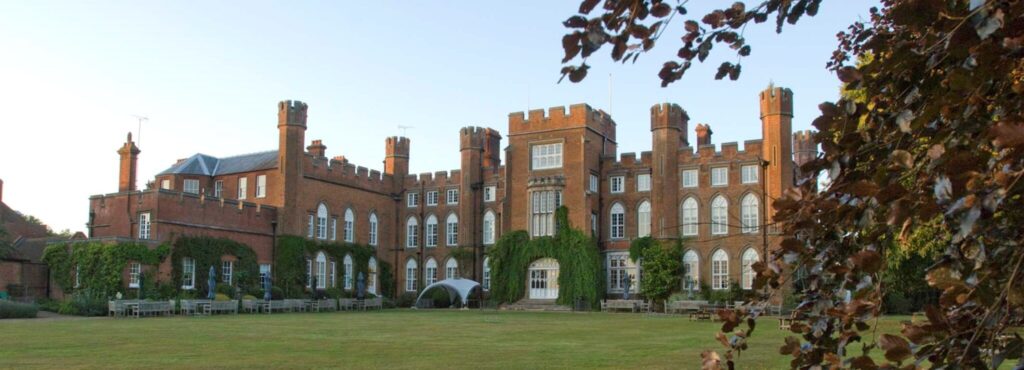
The Cumberland Lodge in Windsor.
The International Association of Geomorphologists (IAG) offers 3 grants of 300 (three-hundred) Euros to PhD STUDENTS in GEOMORHOLOGY from EUROPE (except UK) who are willing to take part in the BSG Post-Graduate Training Workshop (Windsor, UK, 4–7 December 2023). The Windsor workshop is only for PhD students who started in 2023. The Workshop is organised by the British Society for Geomorphology (BSG) and recognised by the IAG.
The course will provide PhD students with elements of training for research and with an opportunity to meet others at an early stage of their training when they are facing the problems of research design etc. The content is non-technical, but provides training in project management, group work, dealing with large data sets, fieldwork, lab and numerical modelling, gaining funding as well as publication and future career development. Students will also meet a wide variety of academics and facilitators who are practicing researchers as well as the BSG postgrad representatives on the Executive.
The workshop has been running at the Cumberland Lodge in Windsor Great Park for over 30 years – many notable researchers and academics attended and benefited from this course.
For further information on the Windsor Workshop, please visit:
https://www.geomorphology.org.uk/windsor-workshop/
Applications from candidates who already achieved one or more IAG grants totalling 500 euros or more in the past 3 years will not be eligible.
Candidates for the IAG GRANTS are requested to submit the following files up to Monday 16 October 2023:
Files should be submitted to:
Anita Bernatek-Jakiel and Efthimios Karymbalis, IAG Training Officers
e-mail: iaggrants@gmail.com (e-mail subject: “BSG Windsor 2023“)
The selection of candidates will be carried out by a Commission appointed by the IAG Executive Committee.
Prof. Efthymios Karymbalis & Dr. Anita Bernatek-Jakiel
IAG Training Officers

The 14th National Symposium of Geomorphology (SINAGEO) in Brazil occurred in Corumbá on August 24th to 30th. To help Young Geomorphologists from Latin America to attend this event, the IAG offered 2 travel grants of 400€ each. The Grant Holders were Paulo Fachin and Mara Mantegazza – congratulation to them! Find their full reports here:

Group photo during fieldwork across the plains and hills of the Pantanal.
Grant Holders highlight a “friendly and welcoming event“, and an global “excellent experience” that was “highly enlightening”. They both appreciated the diversity of activities: classical scientific sessions, but also short courses, workshops, and fieldwork. They also both managed to present their PhD research, and to “make work contacts”. That represented a “gratifying experience”, as they were able to get feedback from experienced researchers working on close topics.
Overall, Mara keeps memory of a “challenging and enriching experience“, as well as a “rewarding social gathering”. Paulo concludes his report by wishing that other Young Geomorphologists from Latin American countries will be able to attend future events with the help of the IAG.

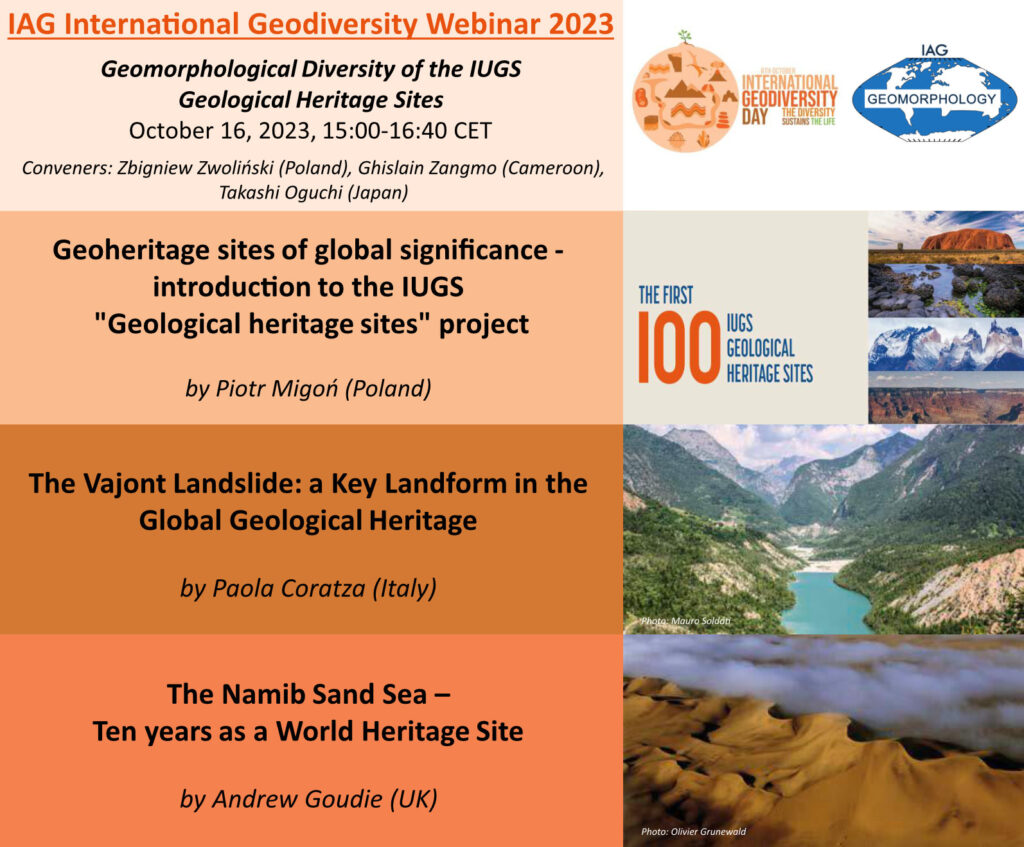 Established in 2021 by the 41st session of the UNESCO General Conference, the International Geodiversity Day occurs each October 6th, and aims at raising awareness of public and policy on the importance of non-living nature.
Established in 2021 by the 41st session of the UNESCO General Conference, the International Geodiversity Day occurs each October 6th, and aims at raising awareness of public and policy on the importance of non-living nature.
To celebrate the second edition of the International Geodiversity Day, the IAG organises a webinar entitled ‘Geomorphological Diversity of the IUGS (International Union of Geological Sciences) Geological Heritage Sites‘! It will be conducted on October 16th, 15:00-16:40 CET. You will listen to 3 speakers from various countries worldwide, who will illustrate the importance of the International Geodiversity Day with concrete examples.
Find the flyer here, and register on Eventbrite here. Find more information on the International Geodiversity Day here.

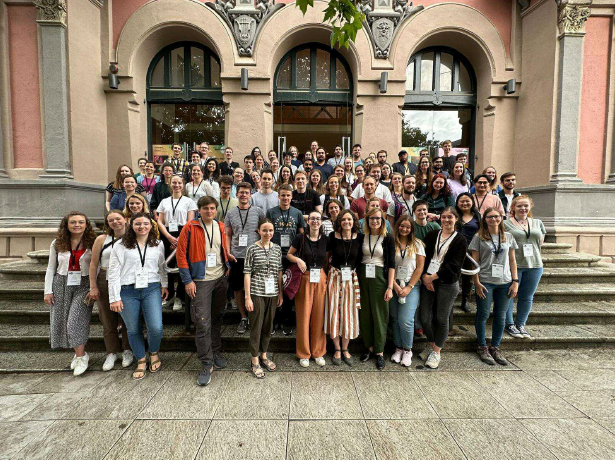
Group photo of the PYRN members at the Workshop
The Permafrost Young Researchers Network (PYRN) organised a workshop during the 6th European Conference on Permafrost (EUCOP 2023). To help Young Geomorphologists to attend this event, the IAG offered two grants of 350€ each to Juditha Aga (Oslo, Norway) and Maike Offer (Munich, Germany). Find their full reports here:
The grant holders highlight a “wonderful experience”, which was “exhilarating” after the period of online meetings due to the global pandemic. Juditha, who was involved in the organisation of the workshop, also specifies that she “learned a lot” as part of the organising committee.
The workshop itself speakers gave “inspiring talks”, both on scientific topics and soft skills related to permafrost research. Following discussions with experienced researchers were especially “interesting and helpful”. Maike especially reports the talk of Adam Kirkwood on preparing presentations and designing slides as “immensely beneficial” for his future career. Both grant holders also keep good memories of the “networking activities” and “informal events” organised as part of the workshop. Overall, the workshop represented a “supportive environment that encouraged collaboration and exchange of ideas”.

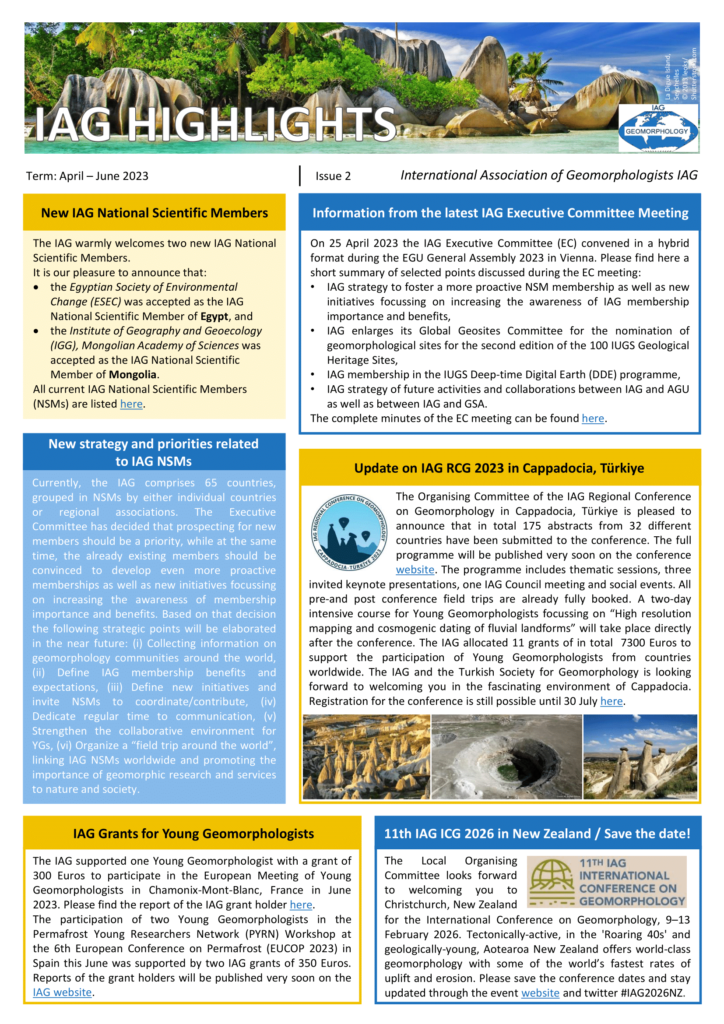 The IAG is happy to release the 2nd issue of its Highlights for 2023, focusing on the period April-June. Find this document in PDF here.
The IAG is happy to release the 2nd issue of its Highlights for 2023, focusing on the period April-June. Find this document in PDF here.


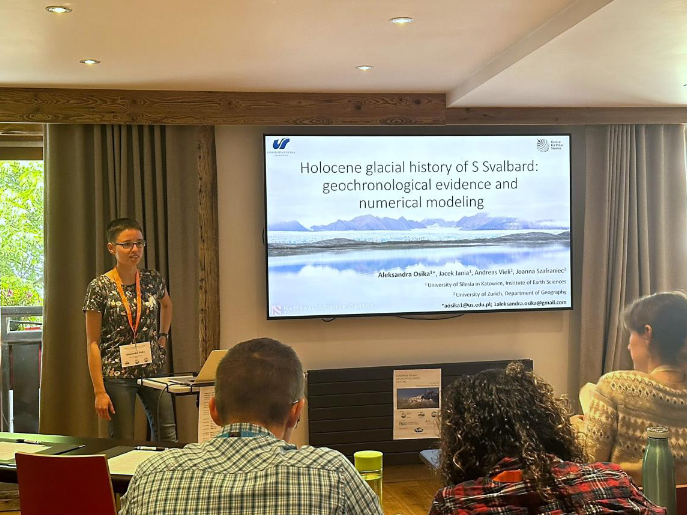
The IAG grant holder, Aleksandra Osika, giving her presentation about the glacial history of South Svalbard
The European Meeting of Young Geomorphologists took place in Chamonix (France) on 9-11 June 2023. To help Young Geomorphologists to attend that event, the IAG offered a grant of 300€ to Aleksandra Osika (Katowice, Poland). Find her full report here.
The Meeting started with a day of conferences divided in three thematic sessions: ‘Dynamic of glacial and periglacial environments’, ‘Geoheritage and geodiversity’, and ‘Methodological advances to innovative case studies’. Aleksandra reports that the ‘inspiring presentations’ led to ‘vibrant and friendly discussions’ all along the Meeting, and she is particularly glad of the ‘positive feedback’ she had on her own presentation.
The next two days of the Meeting were dedicated to field trips in the Mont Blanc Massif, that Aleksandra reports as ‘well organised’. They notably visited the Mer de Glace, an actively retreating glacier, which led to discussions on the ‘perception of the consequences of the ongoing climate change’, especially from the point of view of tourism. They also visit the Ferret Valley, which enabled discussions on the ‘dynamics of rock glaciers and slope processes’ in the area. Overall, Aleksandra describes these field trips as an ‘unforgettable experience’.
For Aleksandra, the Meeting as a whole was ‘scientifically and socially fruitful’, as it allowed her to gain additional knowledge on glacial and periglacial geomorphology, and to establish new scientific contacts.


The International Association of Geomorphologists (IAG) announces the offering of 2 travel grants of 400 € (four hundred Euros) to support the participation of two Young Geomorphologists* from Latin America countries (including Brazil) in the 14th SINAGEO, the National Symposium of Geomorphology in Brazil (Corumbá, 24-30 August 2023).
The 14th SINAGEO is organized by the União da Geomorfologia Brasileira (Brazilian Geomorphological Union) along with the University of Mato Grosso do Sul (UFMS). The focus of that edition is “Geomorphology of Wetlands in the Context of Environmental Changes”, with highlights given to the Pantanal (the largest wetland in the world) and its interactions with current environmental changes. The theme reflects the concerns about the connections between geomorphology and environmental problems, not only in Pantanal, but in the surrounding mountain areas that contribute for a better understanding of environmental changes in this biome. The program includes key-lectures by Brazilian and foreign speakers, short-courses, field trips, workshops, special sessions, and oral and poster presentations. Except for foreign guest appearances, the event will be held in Portuguese.
The two Young Geomorphologists will be granted free admission to the conference, along with access to various activities including a short course of their choice from the event’ list, a one-day field trip to Urucum Massif, and the social dinner. Moreover, they will be able to attend Delta-H, which is a one-day post-conference focused on Quantitative Geomorphology and Landscape Evolution (https://www.deltahbrasil.com). For further information on the 14th SINAGEO, please visit: https://www.sinageo.org.br/en/.
Applications from candidates who already achieved one or more IAG grants totalling 500 euros or more in the past 3 years will not be eligible.
Candidates for IAG GRANTS are requested to submit the following files up to Monday 29 May 2023:
Files should be submitted to:
Anita Bernatek-Jakiel and Efthimios Karymbalis, IAG Training Officers
e-mail: iaggrants@gmail.com (e-mail subject: “14th SINAGEO 2023 “)
The selection of candidates will be carried out by a Commission appointed by the IAG Executive Committee. For further information on the IAG Grants feel free to contact the IAG Training Officers.
Prof. EfthimiosKarymbalis Dr. Anita Bernatek-Jakiel
IAG Training Officer IAG Training Officer
karymba@hua.gr anita.bernatek@uj.edu.pl
*Undergraduate or postgraduate – Masters/PhD students or scientists who have received their highest degree, i.e. BSc, MSc, or PhD, within the past seven years. Provided parental leave fell into that period, up to one year of parental leave time may be added per child, where appropriate.


The IAG is happy to endorse the 17th East Eurasia International Workshop! Organised notably by the Nanjing Institute of Geography and Limnology (Chinese Academy of Science), this event will take place both online and in person in Kunming (China), on 8-12 October 2023. This event aims at sharing cutting-edge and recent advances in that domain, as well as encouraging collaboration and networking among researchers.
The focus of that edition is ‘Present Earth Surface Processes and Long-term Environmental Changes in East Eurasia‘, with highlights given to:
Deadline for registration and abstract submission is 1st August 2023. The Workshop will include regular scientific sessions and plenary sessions, field excursions (karst landforms and Cambrian paleontology), as well as social events. The registration fees are 2000 RMB/290 US$ for in-person participation (including registration and lunch), and are free for online participation. The field excursion fees are 1000 RMB/145 US$ (including 1.5-day trip, lunch, dinner).
Find all details, including contact addresses for registration, on the brief circular or on the full circular.


The IAG announces that the organisation committee of the Regional Conference on Geomorphology (RCG) 2023 extended the deadline for abstract submission to 21st May. Find details on the RCG2023 here. Register and submit your abstract on the website of the conference here.
The IAG offers several grants to help Young Geomorphologists to attend the conference – details here.